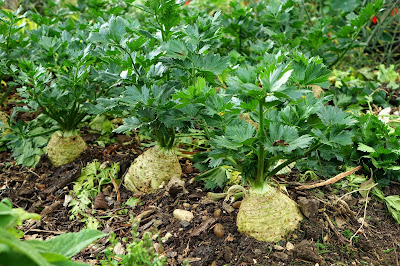 When I talk to other gardeners or look through gardening forums online I get the impression that many people find it difficult to grow decent-sized celeriac. I have to admit that I never had problems growing celeriac, mine typically weigh up to 800 or 900g at harvest, big enough to use for 2 meals for 2 people. If you struggle growing celeriac in your garden or on your allotment why not try out my way of growing this tasty vegetable?
When I talk to other gardeners or look through gardening forums online I get the impression that many people find it difficult to grow decent-sized celeriac. I have to admit that I never had problems growing celeriac, mine typically weigh up to 800 or 900g at harvest, big enough to use for 2 meals for 2 people. If you struggle growing celeriac in your garden or on your allotment why not try out my way of growing this tasty vegetable?1. Start early
 Celeriac needs a long growing season and I always sow the new crop of celeriac when I harvest the last plants from the allotment, which means in a normal year mid-February. I sow the seeds under cover in good seed compost with a sprinkle of vermiculite on top and keep the seeds at about 15-20 C. After germination I wait until the first true leaves appear and then prick the young plants individually into plug trays. I transfer the young plants into 7 cm pots once they are large enough and plant them outside at the beginning of May (later if we have a cold spell).
Celeriac needs a long growing season and I always sow the new crop of celeriac when I harvest the last plants from the allotment, which means in a normal year mid-February. I sow the seeds under cover in good seed compost with a sprinkle of vermiculite on top and keep the seeds at about 15-20 C. After germination I wait until the first true leaves appear and then prick the young plants individually into plug trays. I transfer the young plants into 7 cm pots once they are large enough and plant them outside at the beginning of May (later if we have a cold spell).2. Keep them warm
Celeriac likes it warm and will not appreciate if it is subjected to cold temperatures which will check the growth and might even initiate premature flowering. I keep my celeriac under cover for as long as possible (up to mid-May in colder years) and once they are planted out I protect the young plants with a layer of fleece until about mid-June.
3. Feed and water well
Celeriac needs rich soil which holds moisture well even in dry spells. I always add manure and home-made compost to the bed I have destined for celeriac. It is also important to water well in summer. In dry spells I water every 2-3 days. Once a week I feed the plants with home-made comfrey fertiliser (comfrey leaves fermented in water, 1 part smelly comfrey liquid mixed with 10 part water) which is very effective.
 |
| Celeriac happily growing away in July |
4. Remove outer leaves in late summer and autumn
There is some controversy about this as it is not clear if removing the outer leaves in late summer and autumn really improves the swelling of the celeriac stem (the part we eat) but I always do this and my celeriac always have massive stems (not very scientific, I know!). Maybe in one of the next years, once I have more space, I will set up a little experiment with a proper control (no removal of outer leaves) so I can find out if there really is a difference.
 |
| Celeriac in October, ready to harvest |
5. Harvest, cook and enjoy
Celeriac is not completely winter-hardy but will sit happily outside through winter if you give it some protection with a double-layer of fleece. I normally harvest the last celeriac in February. They last several weeks in the fridge once harvested. Celeriac has a nice aromatic celery flavour, I use it together with potatoes as mash or in soups and stews.





No comments:
Post a Comment